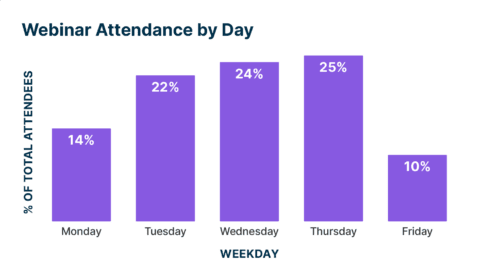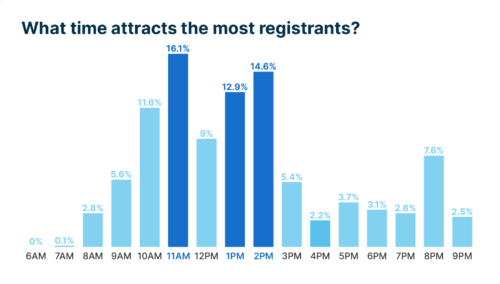Successful webinar hosting for lead generation requires a lot of hard work in preparation, identifying the right audience, and effective promotion to drive attendance. With such an investment on the line, marketers should consider when they schedule their webinars to increase the chances of reaching their target audience.
Knowing when target audiences can and are likely to attend is a crucial component of ideal customer profiles (ICPs) for B2B marketers. This guide identifies key factors webinar hosts should consider when scheduling events and trying to connect with niche B2B audiences.
Key Takeaways:
- In addition to audience targeting and promotion, successful B2B webinar hosting also depends on informed scheduling for optimal days and times during the week
- B2B statistics establish reliable scheduling parameters, but hosts should consider specific audience characteristics as well
- Marketers can enhance webinar appeal for wider timeframes with tactics such as thought leadership marketing, partnership programs, and making on-demand webinars
How To Know the Best Day and Time to Schedule Your Webinar for Lead Generation
Googling the question "What is the best day of the week and time to host a webinar" returns similar, but not entirely consistent, answers from reputable webinar authorities. Nearly all cite weekends and Mondays as the worst-performing days. While older sources tend to discourage scheduling events on Fridays, multi-vendor webinar host ActualTech Media dispels this myth with recent data showing Fridays drawing above average attendance.
As for the middle of the week, WebinarGeek picks Tuesdays and Thursdays over Wednesdays, citing Wednesdays as a popular choice for elective days off. However, according to its data, Zippia has Tuesdays as the lowest of the three, with Wednesdays and Thursdays incrementally increasing.

To figure out the right webinar schedule for your target audience, you can do the following:
Analyze Attendance Data
Working out optimal scheduling parameters for your target audience requires the collection and analysis of data as you host more webinars and compare performance metrics. You’ll promote events in multiple channels such as email, your social media accounts, paid ads, and marketing partners.
Once you’ve sent invitations and posted promotional content for webinars in different time slots and days, you can collect insightful response metrics, such as:
- Soft bounces
- Hard bounces
- Open rates
- Unsubscribes
- Spam flagging
Social Media and Paid Ads
- Impressions
- Click-through rates
- Follows
- Comments
- Likes
As this data set grows, you will develop a better understanding of the weekly habits and preferences of your specific target audience.
Consider Your Webinar Audience’s Demographics and Firmographics
For webinar hosts, demographic and firmographic differences between audiences affect optimal scheduling windows in the same way that differences in platforms affect social media scheduling. To cite a few examples:
- B2B audiences are far more likely to attend during weekday business hours, excluding the 12:00-1:00 pm lunch hour, than B2C audiences, whose own attendance rates go up during weekday evenings
- Among B2B audiences, peak attendance times and days will vary according to attendees' positions in the company, with mid-tier professionals preferring to attend events as part of a standard working hour, while more executive stakeholders are more likely to choose events based solely on the appeal of the content
- Optimal attendance hours for weekday B2B webinars are 11:00 am, 1:00 pm, and 2:00 pm, respectively, but hosts presenting niche topics should also consider the likelihood that their attendees will tune in from geographically scattered locations

Tips for Mitigating Scheduling Challenges
Webinar attendance statistics suggest reliable guidelines for scheduling, with the middle of the week and middle of the day generally winning out for B2B audiences. Nevertheless, every audience is unique. The more specialized the product and the more targeted the ICP, the more the hosting organization's perceived authority and expertise will appeal directly to potential attendees. Likewise, the more targeted a segment of promotional content reaches, the more high-quality registrants an event will garner.
Among marketing approaches to taking advantage of these opportunities, webinar hosts can use these established tactics to enhance attendance quantity and quality:
Thought Leadership Marketing
Among C-level business leaders, 90% confirm that thought leadership content directly influences their decisions, compared to just 17% for standard marketing content. Thought leadership marketing refers to actions to position a business as a respected authority in an industry or niche field. Focusing on quality over quantity in content creation, building thought leadership involves addressing high-level business challenges with analytical, long-form content such as e-books, whitepapers, and webinars featuring expert presenters. With the potential to deliver 7-8 times superior ROI over technical SEO and standard content marketing practices, thought leadership pays off in the long term.
Partner Programs
Partner programs are agreements between two or more businesses to work towards mutually beneficial goals, such as coordinating the marketing of two products as a package deal or exchanging cross-promotion or sales for commission. Common partner program examples include:
- Integration Partnership: Involves two businesses marketing a pair of products as a recommended set for maximum value. Integration partnerships are popular in tech, where 69% of B2B software-as-a-service (SaaS) vendors co-market partner platforms
- Channel Partnership: Occurs when a business sells products or services for commission through a third party with access to outside markets
- Strategic Partnership: Comprises arrangements when two non-competing businesses pool marketing resources such as market data, training, or even physical locations to capitalize on each other's strengths
On-Demand Webinar Content
Beyond refining scheduling patterns to match the unique preferences of your target audience, hosts can drive webinar attendance and content ROI by making webinars available on-demand to audiences after the live event. In fact, 47% of views for webinars kept open for on-demand viewing occur during the following first 10 days.
As the cost is negligible and the potential return is quite substantial, making past webinars available on-demand should be standard practice for any business employing a webinar-based B2B content strategy.
Excel in Lead Generation with ActualTech's Webinar Services
Choosing the best time to schedule a webinar is only one aspect of hosting a successful online event. Let ActualTech do the hard work for you in creating and scheduling an outstanding webinar for lead generation.
Get a price list of our webinar lead generation services today.